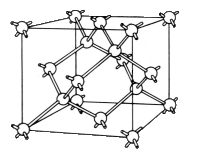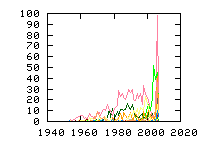« Previous
1
Next »
(17 hits, 1/1)
Showing
10, 25, 50, 100, 500, 1000, all papers per page.
Sort by:
last publication date,
older publication date,
last update date.
- 1. Appl. Phys. Lett. 90, 023112 (2007) , “Electrically tunable defects in metallic single-walled carbon nanotubes”, Ji-Yong ParkA defect whose electron transmission probability can be controlled by electric field is intentionally created on a metallic single-walled carbon nanotube (SWCNT) with a voltage pulse from a tip of an atomic force microscope (AFM). Localized characteristics of the created defect are elucidated with... (Read more)
- 2. Phys. Rev. B 75, 193409 (2007) , “Magnetic properties of vacancies in a graphitic boron nitride sheet by first-principles pseudopotential calculations”, M. S. Si and D. S. XueWe use ab initio methods to calculate the magnetic properties of vacancies in a graphitic boron nitride sheet (g-BN). By applying a full spin-polarized description to the system, we demonstrate that the nitrogen vacancy (VN) or the boron vacancy (VB)... (Read more)
- 3. Phys. Rev. B 75, 144103 (2007) , “Multiscale modeling of point defects in Si-Ge(001) quantum wells”, B. Yang and V. K. TewaryA computationally efficient hybrid Green's function (GF) technique is developed for multiscale modeling of point defects in a trilayer lattice system that links seamlessly the length scales from lattice (subnanometers) to continuum (bulk). The model accounts for the discrete structure of the lattice... (Read more)
- 4. Phys. Rev. B 75, 115113 (2007) , “Structural, electronic, and magnetic properties of Mn-doped Ge nanowires by ab initio calculations”, J. T. Arantes, Antônio J. R. da Silva, and A. FazzioUsing ab initio total energy density-functional theory calculations, we investigated the electronic, structural, and magnetic properties of manganese-doped germanium nanowires. The nanowires have been constructed along the [110] direction and the dangling bonds on the surface have been... (Read more)
- 5. Phys. Rev. B 75, 113401 (2007) , “Enhancing the topological structures of defected carbon nanotubes with adsorbed hydrocarbon radicals at low temperatures”, R. L. Zhou, H. Y. He, and B. C. PanRealistic carbon nanotubes (CNTs) contain various structural defects by which the physical and chemical properties of the CNTs are significantly influenced. So, lowering the defect densities is of importance for the potential application of the CNTs. By performing tight-binding molecular dynamics... (Read more)
- 6. Phys. Rev. B 75, 085416 (2007) , “Ab initio theoretical study of hydrogen and its interaction with boron acceptors and nitrogen donors in single-wall silicon carbide nanotubes”, A. GaliSilicon carbide nanotubes have a great potential for biological applications. It is of interest to explore the electronic properties of these nanotubes, and how those are modified in the presence of impurities. Hydrogen is a common impurity that can appear during the growth of silicon carbide... (Read more)
- 7. Phys. Rev. B 75, 075420 (2007) , “Ab initio study of hydrogen interaction with pure and nitrogen-doped carbon nanotubes”, Zhiyong Zhang and Kyeongjae ChoDetailed studies of mechanisms for hydrogen dissociative adsorption and diffusion on pure and nitrogen-doped (8, 0) carbon nanotubes are carried out using the first-principles density functional theory method. (1) For pure carbon nanotubes, we have identified the energetically most favorable... (Read more)
- 8. Phys. Rev. Lett. 98, 252501 (2007) , “Radioactive Decay Speedup at T=5 K: Electron-Capture Decay Rate of 7Be Encapsulated in C60”, T. Ohtsuki, K. Ohno, T. Morisato, T. Mitsugashira, K. Hirose, H. Yuki, and J. KasagiThe electron-capture (EC) decay rate of 7Be in C60 at the temperature of liquid helium (T=5 K) was measured and compared with the rate in Be metal at T=293 K. We found that the half-life of 7Be in endohedral C60... (Read more)
- 9. Phys. Rev. Lett. 98, 075503 (2007) , “Pseudoclimb and Dislocation Dynamics in Superplastic Nanotubes”, Feng Ding, Kun Jiao, Mingqi Wu, and Boris I. YakobsonPlastic relaxation of carbon nanotubes under tension and at high temperature is described in terms of dislocation theory and with atomistic computer simulations. It is shown how the glide of pentagon-heptagon defects and a particular type of their pseudoclimb, with the atoms directly breaking out of... (Read more)
- 10. J. Appl. Phys. 100, 034309 (2006) , “Critical size for defects in nanostructured materials”, Jagdish NarayanThis paper addresses some of the fundamental issues and critical advantages in reducing the grain size/feature size to the nanoscale regime. We find that as the grain size or feature size is reduced, there is a critical size below which the defect content can be reduced virtually to zero. This... (Read more)
- 11. Phys. Rev. B 74, 245420 (2006) , “Energetics, structure, and long-range interaction of vacancy-type defects in carbon nanotubes: Atomistic simulations”, J. Kotakoski, A. V. Krasheninnikov,, and K. NordlundThe presence of vacancy clusters in carbon nanotubes has been assumed to explain the formation of carbon peapods and the difference between the experimentally measured and theoretical fracture strength of nanotubes. We use atomistic simulations at various levels of theory to study the... (Read more)
- 12. Phys. Rev. B 74, 245411 (2006) , “Vacancy defects and the formation of local haeckelite structures in graphene from tight-binding molecular dynamics”, Gun-Do Lee, C. Z. Wang, Euijoon Yoon, Nong-Moon Hwang, and K. M. HoThe dynamics of multivacancy defects in a graphene layer is investigated by tight-binding molecular dynamics simulations and by first principles calculation. The simulations show that four single vacancies in the graphene layer first coalesce into two double vacancies, each consisting of a... (Read more)
- 13. Phys. Rev. B 74, 155425 (2006) , “Ab initio study of native defects in SiC nanotubes”, R. J. Baierle, P. Piquini, L. P. Neves, and R. H. MiwaSpin-polarized density functional theory is used to investigate the electronic and structural properties of vacancies and antisites in zigzag, armchair, and chiral SiC nanotubes. Antisites present lower formation energies compared to vacancies, introducing an empty electronic level close to the... (Read more)
- 14. Phys. Rev. B 74, 153403 (2006) , “Doping and the unique role of vacancies in promoting the magnetic ground state in carbon nanotubes and C60 polymers”, Antonis N. Andriotis, R. Michael Sheetz, and Madhu MenonThe role of various types of defects in establishing the magnetic properties of the C60-based polymers and the single-wall carbon nanotubes is investigated. Comparing the role of carbon vacancies, and that of substitutional impurity atoms X (X=N, B, O, Si, P, and S) in... (Read more)
- 15. Phys. Rev. B 74, 035202 (2006) , “Computation of the Stark effect in P impurity states in silicon”, A. Debernardi, A. Baldereschi, and M. FanciulliWe compute within the effective-mass theory and without adjustable parameters the Stark effect for shallow P donors in Si with anisotropic band structure. Valley-orbit coupling is taken into account in a nonperturbative way and scattering effects of the impurity core are included to properly... (Read more)
- 16. Phys. Rev. B 73, 245415 (2006) , “Ab initio study of nitrogen and boron substitutional impurities in single-wall SiC nanotubes”, A. GaliSilicon carbide nanotubes have a great potential for application in chemical sensors in harsh environment or in biological sensors. It is of interest to explore the electronic properties of these nanotubes, and how those are modified in the presence of impurities. It is well known that nitrogen and... (Read more)
- 17. Phys .Rev. Lett. 92, 178302 (2004) , “Nonvolatile Memory with Multilevel Switching: A Basic Model”, M. J. Rozenberg, I. H. Inoue, and M. J. SánchezThere is a current upsurge in research on nonvolatile two-terminal resistance random access memory (RRAM) for next generation electronic applications. The RRAM is composed of a simple sandwich of a semiconductor with two metal electrodes. We introduce here an initial model for RRAM with the... (Read more)
« Previous
1
Next »
(17 hits, 1/1)
Showing
10, 25, 50, 100, 500, 1000, all papers per page.
Sort by:
last publication date,
older publication date,
last update date.
All papers (3399)
Updated at 2010-07-20 16:50:39
Updated at 2010-07-20 16:50:39
(view as: tree
,
cloud
)
| 1329 | untagged |
Materials
(111 tags)
Others(101 tags)
Technique
(46 tags)
Details
(591 tags)
Bond(35 tags)
Defect(interstitial)(18 tags)
Defect(vacancy)(15 tags)
Defect-type(19 tags)
Element(65 tags)
Energy(8 tags)
Isotope(56 tags)
Label(303 tags)
Sample(17 tags)
Spin(8 tags)
Symmetry(15 tags)

